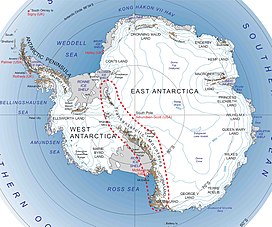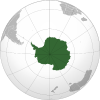Transantarctic Mountains
| Transantarctic Mountains | |
|---|---|
Cape Roberts | |
| Highest point | |
| Peak | Mount Kirkpatrick |
| Elevation | 4,528 m (14,856 ft) |
| Coordinates | 84°20′S 166°25′E / 84.333°S 166.417°E |
| Dimensions | |
| Length | 3,500 km (2,200 mi) |
| Geography | |
| Continent | Antarctica |
| Range coordinates | 85°S 175°W / 85°S 175°W |
| Geology | |
| Age of rock | Cenozoic |
The Transantarctic Mountains (abbreviated TAM) comprise a mountain range of uplifted rock (primarily sedimentary) in Antarctica which extends, with some interruptions, across the continent from Cape Adare in northern Victoria Land to Coats Land. These mountains divide East Antarctica and West Antarctica. They include a number of separately named mountain groups, which are often again subdivided into smaller ranges.
The range was first sighted by
Geography

The mountain range stretches between the Ross Sea and the Weddell Sea, the entire width of Antarctica, hence the name. With a total length of about 3,500 km (2,000 mi), the Transantarctic Mountains are one of the longest mountain ranges on Earth. The Antarctandes are even longer, having in common with the Transantarctic Mountains the ranges from Cape Adare to the Queen Maud Mountains, but extending thence through the Whitmore Mountains and Ellsworth Mountains up the Antarctic Peninsula. The 100–300 km (60–200 mi) wide range forms the boundary between East Antarctica and West Antarctica. The East Antarctic Ice Sheet bounds the TAM along their entire length on the Eastern Hemisphere side, while the Western Hemisphere side of the range is bounded by the Ross Sea in Victoria Land from Cape Adare to McMurdo Sound, the Ross Ice Shelf from McMurdo Sound to near the Scott Glacier, and the West Antarctic Ice Sheet beyond.
The summits and dry valleys of the TAM are some of the few places in Antarctica not covered by ice, the highest of which rise more than 4,500 metres (14,800 ft) above sea level. The McMurdo Dry Valleys lie near McMurdo Sound and represent a special Antarctic phenomenon: landscapes that are snow and ice-free due to the extremely limited precipitation and ablation of ice in the valleys. The highest mountain of the TAM is the 4,528 m (14,856 ft) high Mount Kirkpatrick in the Queen Alexandra Range.
Biology
Penguins, seals, and sea birds live along the Ross Sea coastline in Victoria Land, while life in the interior of the Transantarctic Range is limited to bacteria,
History
The Transantarctic Mountains were first seen by Captain James Clark Ross in 1841 from the Ross Sea. The range is a natural barrier that must be crossed to reach the South Pole from the Ross Ice Shelf.
The first crossing of the Transantarctic Mountains took place during the 1902–1904
Much of the range remained unexplored until the late 1940s and 1950s, when missions such as Operation Highjump and the International Geophysical Year (IGY) made extensive use of aerial photography and concentrated on a thorough investigation of the entire continent. The name "Transantarctic Mountains" was first applied to this range in a 1960 paper[2] by geologist Warren B. Hamilton, following his IGY fieldwork. It was subsequently recommended by the Advisory Committee on Antarctic Names, a US authority on geographic names, in 1962. This purely descriptive label (in contrast to many other geographic names on Antarctica) is internationally accepted at present.
The
Geology

The Transantarctic Mountains are considerably older than other
The mountains consist of
Ice from the
See also


In geographic order, from the Ross Sea towards the Weddell Sea:
Victoria Land
- Lillie Glacier
- Concord Mountains
- Cape Adare
- Admiralty Mountains
- Cape Hallett
- Tucker Glacier
- Victory Mountains
- Mariner Glacier
- Aviator Glacier
- Terra Nova Bay
- Priestley Glacier
- Prince Albert Mountains
- Ferrar Glacier
- McMurdo Sound
Central TAM
Queen Maud Mountains
- Shackleton Glacier
- Liv Glacier
- Amundsen Glacier
- Scott Glacier
- Bush Mountains
- Commonwealth Range
- Dominion Range
- Herbert Range
- Prince Olav Mountains
- Hughes Range
- Supporters Range
- Zorawar Range
"Southern" TAM
- Reedy Glacier
- Horlick Mountains
- Thiel Mountains
- Pensacola Mountains
- Shackleton Range
- Theron Mountains
Further reading
- Gunter Faure, Teresa M. Mensing, The Transantarctic Mountains: Rocks, Ice, Meteorites and Water, Springer
- Damien Gildea, Transantarctic Mountains - Mountaineering in Antarctica: Travel Guide
- Sokol, E. R., C. W. Herbold, C. K. Lee, S. C. Cary, and J. E. Barrett, Local and regional influences over soil microbial metacommunities in the Transantarctic Mountains, Ecosphere 4(11):136. https://dx.doi.org/10.1890/ ES13-00136.1 2013
- I.B. Campbell, G.G.C. Claridge, Antarctica: Soils, Weathering Processes and Environment, PP 30 – 32
- A.R. Lewis, D.R. Marchant, A.C. Ashworth, S.R. Hemming, M.L. Machlus, Major middle Miocene global climate change: Evidence from East Antarctica and the Transantarctic Mountains


